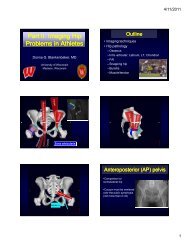Ankle and Foot 47 - Department of Radiology - University of ...
Ankle and Foot 47 - Department of Radiology - University of ...
Ankle and Foot 47 - Department of Radiology - University of ...
Create successful ePaper yourself
Turn your PDF publications into a flip-book with our unique Google optimized e-Paper software.
A<br />
B<br />
C<br />
<strong>47</strong> <strong>Ankle</strong> <strong>and</strong> <strong>Foot</strong> 2307 <strong>47</strong><br />
Figure <strong>47</strong>-110. Fracture <strong>of</strong> the medial sesamoid in a<br />
27-year-old with a several-month history <strong>of</strong> pain<br />
localized to the head <strong>of</strong> the first metatarsal. Short-axis<br />
T1-weighted (A) <strong>and</strong> T2-weighted fat-suppressed (B)<br />
images show normal bone marrow signal in the lateral<br />
sesamoid (white arrow) <strong>and</strong> bone marrow edema in<br />
the medial sesamoid (black arrow). C, Bone scan, bothfeet-on-detector<br />
view, localizes the increased uptake<br />
to the medial sesamoid <strong>of</strong> the left foot. This patient<br />
failed to respond to conservative therapy <strong>and</strong><br />
ultimately had the medial sesamoid resected.<br />
Infection<br />
Osteomyelitis is always a diagnostic dilemma. The term<br />
osteomyelitis comes from the Greek roots osteon meaning<br />
“bone,” myelos meaning “marrow,” <strong>and</strong> itis meaning<br />
“inflammation.” Thus, osteomyelitis literally means “inflammation<br />
<strong>of</strong> bone marrow,” <strong>and</strong> this is perhaps symbolic <strong>of</strong><br />
the dilemma. MRI is extremely sensitive for the detection<br />
<strong>of</strong> marrow inflammation, but it is not specific for the<br />
inflammation caused by infection. By MRI, the bone<br />
marrow edema caused by infection looks just like the bone<br />
marrow edema caused by a stress response as well as the<br />
edema caused by a nonhealing fracture or even a healing<br />
fracture. For this reason, an MRI for osteomyelitis should<br />
not be read in isolation. It is difficult to arrive at the correct<br />
diagnosis without a thorough clinical workup <strong>and</strong><br />
complete underst<strong>and</strong>ing <strong>of</strong> any prior surgical resections or<br />
debridements.<br />
• Imaging Techniques<br />
• Radiography<br />
Radiographs are essential in the workup <strong>of</strong> osteomyelitis,<br />
<strong>and</strong> at the UW we insist on having recent radiographs<br />
before we will perform an MRI for infection. Although it<br />
is true that radiographs are insensitive to the bone marrow<br />
<strong>and</strong> s<strong>of</strong>t tissue edema seen on MRI, they are not without<br />
value. First, radiographs are crucial to screen for the presence<br />
<strong>of</strong> metal, particularly in the feet <strong>of</strong> diabetic patients<br />
who may be insensate <strong>and</strong> thus unknowingly stepped<br />
on pins, not to mention the presence <strong>of</strong> orthopedic<br />
hardware.<br />
Second, in diabetic feet it is necessary to screen for the<br />
joint-centered collapse that is typically seen with peripheral<br />
neuropathy, the Charcot joint. These radiographic<br />
findings have been described as “the six Ds”: destruction,<br />
increased density, dislocation, debris, distension, <strong>and</strong> disorganization.<br />
The bone marrow <strong>and</strong> s<strong>of</strong>t tissue edema seen<br />
with MRI in patients with sterile neuropathic osseous<br />
changes may be indistinguishable from infection, <strong>and</strong> for<br />
this reason at the UW we recommend that patients who<br />
exhibit radiographic findings <strong>of</strong> a Charcot joint undergo a<br />
nuclear medicine bone scan <strong>and</strong> white blood cell scan,<br />
rather than MRI, for the workup <strong>of</strong> osteomyelitis. And<br />
because neuropathic collapse can occur relatively quickly<br />
<strong>and</strong> go unnoticed by a patient with an insensate foot (Fig.<br />
<strong>47</strong>-111), we require that the pre-MRI radiographs be recent,<br />
preferably within the last week.<br />
Third, radiographs may reveal findings that, in the<br />
proper clinical setting, are diagnostic for osteomyelitis.<br />
New cortical erosions (Fig. <strong>47</strong>-112) in a bone deep to a<br />
nonhealing ulcer or unresponsive cellulitis are as diagnostic<br />
as MRI for active osteomyelitis. Periosteal reactions,<br />
particularly the aggressive periosteal reaction <strong>of</strong> acute<br />
osteomyelitis or the thick involucrum <strong>of</strong> chronic osteomyelitis<br />
(Fig. <strong>47</strong>-113), can be diagnostic. Gas in the s<strong>of</strong>t<br />
tissues, such as from a gas-forming organism, is easily<br />
detected on radiographs yet may be hard to interpret on<br />
MRI because it can cause susceptibility artifacts similar to<br />
those caused by metal.<br />
• Magnetic Resonance Imaging<br />
Ultimately, it is easier to rule out osteomyelitis by MRI than<br />
it is to confirm its presence. The absence <strong>of</strong> increased bone<br />
marrow signal on a good edema-sensitive MRI effectively<br />
Ch0<strong>47</strong>-A05375.indd 2307<br />
9/9/2008 5:36:09 PM
















